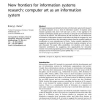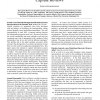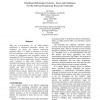EJIS
2006
13 years 12 months ago
2006
This paper proposes extending the frontiers of information systems (IS) research by seeing computer art as a kind of information system. It explores some research questions that a...
CSCW
2006
ACM
13 years 12 months ago
2006
ACM
The pressure towards tighter or ``seamless'' integration of health information systems is a recurring issue with both practical and analytical relevance. It taps into a d...
CORR
2006
Springer
13 years 12 months ago
2006
Springer
Cultural heritage documentation induces the use of computerized techniques to manage and preserve the information produced. Geographical information systems have proved their pote...
CJ
2006
13 years 12 months ago
2006
s the development of an abstract description of what there is in the world in an application-independent form. This paper argues that attempts to support information systems intero...
EJIS
2008
13 years 12 months ago
2008
We outline a Punctuated Socio-Technical Information System Change model. The model recognizes both incremental and punctuated socio-technical change in the context of information ...
WWW
2010
ACM
14 years 1 days ago
2010
ACM
As traditional media and information devices integrate with the web, they must suddenly support a vastly larger database of relevant items. Many devices use remote controls with o...
AVI
2010
14 years 29 days ago
2010
Content classification performed by end users is spreading through the web. Most of the work done so far is related to the hypermedia web. In spite of that, there is a growing mas...
VVEIS
2007
14 years 1 months ago
2007
Being the de-facto standard (object-oriented-OO) method(-logy) for software-intensive systems development, UML with its different diagrams and supporting tools represent nowadays t...
ICIS
1997
14 years 1 months ago
1997
There are many in the information systemsdiscipline who believe that user participation is necessary for successful systems development. However, it has been suggested that this b...
PDSE
1998
14 years 1 months ago
1998
With the ever-increasing use of object-oriented middleware in distributed information systems, new challenges are facing the software engineering profession. Often, it is simply a...









